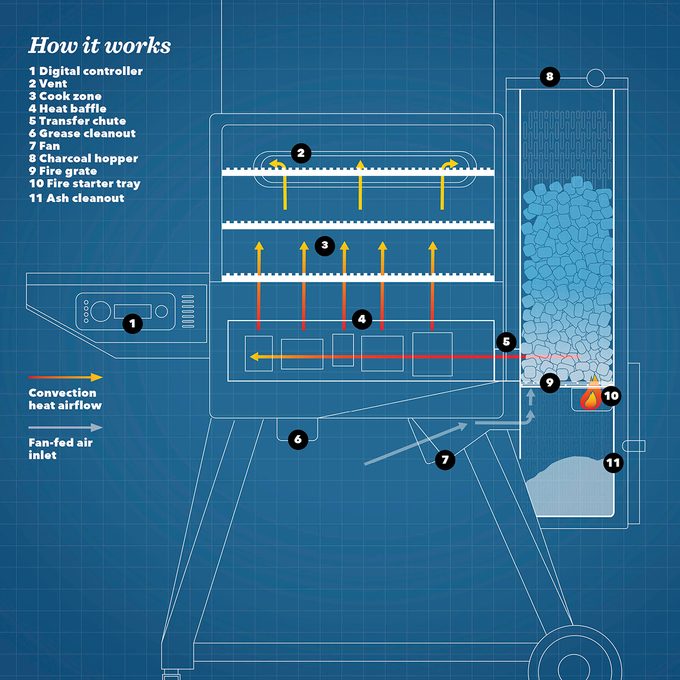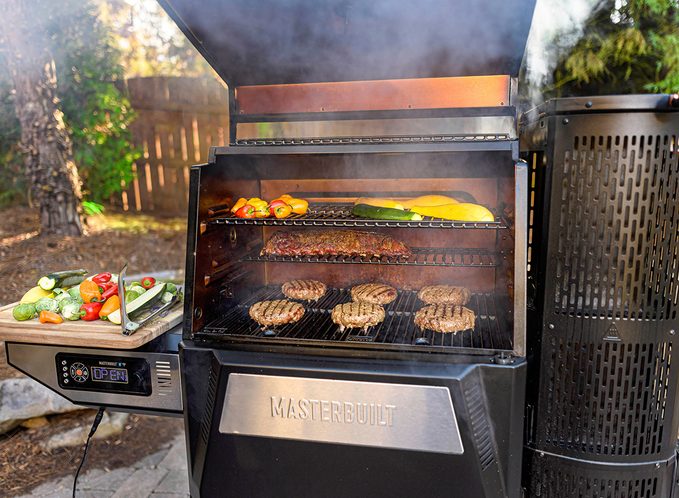Humans have been grilling food since the domestication of fire. This outdoor ritual eventually went indoors, evolving into the ease and predictability of the modern kitchen. Cooking went outdoors again with the post-war boom that brought us the “Weber” style charcoal grill. Today, there’s a renaissance of grilling, with grills becoming extensions of our kitchens.
Are you considering a new grill and want to get the most out of it? Knowing how your grill works is the foundation for great food. So in this article, you’ll learn about the operation and cooking characteristics of three popular grill types from a few modern grilling masters.
The Pellet Grill

A Smoking Oven
Pellet grills/smokers resulted from the 1973 oil crisis, as we searched for alternative fuel sources for furnaces. Joe Traeger figured out how to use compressed sawdust pellets to fuel a grill. Traeger held the patent on this grill until 2006. Then mass production brought a wave of innovation, transforming them into sophisticated appliances.
His original design shines through in today’s pellet grills. The pellets go in a hopper, where a motorized auger delivers them to a fire pot with an electric heating element. A fan then aids combustion and circulates the hot air.
Most modern pellet grills employ digital automation for app-based control. A thermostat in the cooking chamber automates the fan and auger operation. You can program your grill to cook at a specific temperature for a determined length of time. Some grills integrate leave-in meat probes to hold a temperature once the food reaches a set point.
“I think finally we’re at the point where the grill is an appliance and people aren’t going to just go get that poorly made $200 grill that happened to be at the corner hardware store. They want something that’s going to last and yields consistent results year-round.”
Diva Q
Traeger pellet grills are highly regarded and the choice of many celebrated outdoor chefs. Diva Q is one of those chefs, and I caught up with her to find out what makes her such a devotee.
“When I first started in competitive barbecue, lots of guys were put off by a woman with a pellet grill,” she says. “But once I proved myself, those same guys are now asking advice on how to use the pellet grill, wishing they’d listened when I said, ‘You know I’m working smarter, not harder, right?’ ”
For Diva Q, her pellet grill yields the “most consistent results with the easiest learning curve,” opening the door for grilling newbies and enabling veterans to experiment. While the new app-controlled pellet grills are easy to use, there are some essentials to learn.
“One of the key things is, not all pellets are created equal,” she says, adding the compression rate, moisture content and sourcing of the wood all play key parts in a quality pellet. Softwood is not great and is usually what’s in cheap pellets. All-natural hardwood gives the best fire and flavor. The flavor profiles of apple, cherry, hickory, and oak are all different.
Diva Q feels it’s best to establish a base flavor that’s softer, then mix in a harder one like mesquite. Also, the hotter a pellet grill gets, the less smoke it produces. This is good for baking and high-temperature dishes that don’t need smoke. But at temps less than 250 F, she says “they produce all kinds of beautiful mild smoke that brings that great flavor to the food.”
Most pellet grills don’t sear a steak as well as a gas or charcoal grill. But Diva Q says she’s learned a lot about the science of grilling, and she now knows that caramelization for the desired char from searing still happens with low, indirect heat. With a pellet grill, you can still get what’s called the “Maillard reaction,” which gives browned food its singular flavor, but not with the same high-heat char like on a direct heat charcoal or gas grill.
Diva Q says she can smell when the sugars are changing with low heat, and she doesn’t really need an app to cook. She will use the Traeger app if she leaves the grill unattended. She says the real benefit of the app is its library of recipes. They designate timing, temperature and serving size, all enabling anyone to execute exceptional grilled food.

Meet the Expert:
Diva Q lives, breathes, and eats barbecue all over the world. She has starred in countless barbecue competitions and can be found teaching, judging and tasting anywhere barbecue is served.
Kamado Grill

The Clay Pot Cooker
Other than the lid, a kamado grill has two moving parts: the lower draft door, and the top control or chimney cap. Chef Eric (you’ll meet him in a second) sees the draft door as a heat pump, sucking in ambient air to create convection. Closing that draft door is like putting on the brakes; this is where you execute big temperature changes.
The chimney cap regulates smaller changes in temperature. The cooking grate sits on the fire ring above the firebox, also ceramic. An optional heat deflector aids indirect cooking. All these ceramic components retain temperature for an even distribution of heat.

“It’s a primal way to cook, which is a beautiful thing these days. You’re in the moment, you’re interacting with the charcoal, you’re building that fire, you’re present. It’s about mindfulness and, hopefully, not thinking about your cell phone.”
Chef Eric
These grills have been around for thousands of years, but only since World War II has the Japanese kamado been grilling deliciousness in the United States. The kamado grill’s ceramic outer shell and inner parts retain heat far better than a steel grill. This results in a slower, more efficient and controlled burn.
Their popularity coincided with the rise of “foodie” culture, and they’re now available at most home centers and hardware stores. I spoke with kamado guru “Chef Eric” Gephart to glean some knowledge about this archaeologic treasure of a grill.
Many say a kamado heats up slower than other charcoal or gas grills. Chef Eric says that if you have quality lump charcoal and the right approach, you’ll have a usable fire in 10 to 15 minutes. Once you have flame, close the lid and adjust the draft door and control cap to find your desired temp.
This is a crucial point of control with a kamado. If you leave that cap and draft door open too long, the draft will stoke the coals and the temp can quickly climb as high as 750 F. A kamado is so efficient at holding heat that it’s difficult to drop temperature quickly. If you want a slow, low-temp cook, increase the temperature gradually.
The upside of the kamado’s quick flash heat is that you can slow-smoke food and then finish it with a quick sear by opening up both vents and even the lid for immediate, high heat.
The most popular kamado grills are 18 to 22 inches in diameter, but they come as large as 42 inches. Chef Eric said all grill sizes perform the same way. The only difference is what he calls “grill estate.” The more grill space you have, the greater the options for different cook zones, or “heat signatures,” as he referred to them.
Banking the charcoal to one side creates separate areas of direct and indirect heat, allowing you to cook different foods simultaneously. Larger grills often have secondary grates or racks for even more “grill estate.” Combine this with a rotisserie or other accessories and “you can have a culinary jungle gym,” says Chef Eric.
Chef Eric sees more and more culinary aspirants drawn to kamado grills. Chef Eric has used a kamado grill to execute everything from Bretagne-style apple cake to triple cream beer bratwurst and, yes, of course, some serious barbecue brisket.

Meet the Expert:
Chef Eric Gephart is the “Live Fire Culinary Expert” at Kamado Joe. He has taken his high-performance grilling adventures around the world, spreading his passion for food, sustainability and mindfulness to everyone he meets.
Gravity-Fed Charcoal

More Than Just Gravity
The basic design of gravity-fed charcoal cookers is simple: A tall charcoal hopper sits to one side of the cooker, gravity-feeding fuel into the firebox. An air inlet in the firebox regulates oxygen. Heat and smoke from the firebox flow through a transfer chute and hit the heat baffle that’s centered below the cooking zone.
Above the heat baffle sits a grease shield or drip pan with a cleanout tray. The cook chamber has a cooking grate directly over the heat baffle and two or more cooking racks above it. At the top of the chamber, a chimney vents heat and smoke from the firebox up around the cooking zone. There’s typically an ash cleanout below the fire grate.

“The design of this grill allows both the novice and the seasoned grill chef to execute more creative and adventurous recipes because their focus is on the food, not the flame.”
Daniel Mercer
Gravity-fed charcoal smokers came on the competitive barbecue scene in the 1990s. Their self-feeding mechanism put an end to staying up all night stoking smokers. Initially, these were custom DIY builds, made by a handful of boutique manufacturers. But their popularity quickly put them into the home consumer market.
Until recently, most gravity-fed units were for serious barbecue enthusiasts with big budgets. But design innovations have made these units more user-friendly and affordable. Adam Carter and Daniel Mercer from Masterbuilt have taken gravity-fed charcoal to a new level of “set it and forget it” with automation technology, bringing capabilities not previously seen on this grill type.
A fan stoking the firebox automatically adjusts to maintain temperature. It’s linked to your phone, so you can monitor your grill remotely. This adds convenience and pinpoint temperature control but also means fast temperature change — up to 700 F within 15 minutes. No fussing with fuel or airflow dampers. With this temperature control, you can sear a steak just as easily as slow-cook a rack of ribs.
Does all this convenience remove the art and craft from grilling? “The creativity with this grill comes in how you layer wood chips in with your fuel, or use the fast temperature control to cook several different things for a meal,” Daniel says. The ability to use technology to dial in that delicious charcoal flavor without tending a fire removes the barrier to having a great grilling experience every time.
Meet the Experts:

Daniel Mercer (left) and Adam Carter are the masterminds behind Masterbuilt’s gravity-fed charcoal grills. Their passion for engineering is as strong as their appetite for good Southern barbecue.
Article source here: Next Generation Grills



No comments:
Post a Comment